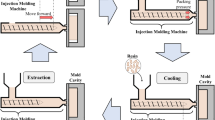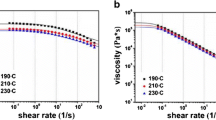Abstract
The high energy intensity and rigorous quality demand of injection molding have received significant interest under the background of the soaring production of global plastic industry. As multiple parts can be produced in a multi-cavity mold during one operation cycle, the weight differences of these parts have been demonstrated to reflect their quality performance. In this regard, this study incorporated this fact and developed a generative machine learning-based multi-objective optimization model. Such model can predict the qualification of parts produced under different processing variables and further optimize processing variables of injection molding for minimal energy consumption and weight difference amongst parts in one cycle. Statistical assessment via F1-score and R2 was performed to evaluate the performance of the algorithm. In addition, to validate the effectiveness of our model, we conducted physical experiments to measure the energy profile and weight difference under varying parameter settings. Permutation-based mean square error reduction was adopted to specify the importance of parameters affecting energy consumption and quality of injection molded parts. Optimization results indicated that the processing parameters optimization could reduce ~ 8% energy consumption and ~ 2% weight difference compared with the average operation practices. Maximum speed and first-stage speed were identified as the dominating factors affecting quality performance and energy consumption, respectively. This study could contribute to the quality assurance of injection molded parts and facilitate energy efficient and sustainable plastic manufacturing.















Similar content being viewed by others
References
Akar Ö, Güngör O (2012) Classification of multispectral images using Random forest algorithm. J Geod Geoinf 1:105–112
Arisoy EB, Musuvathy S, Mirabella L, Slavin E III (2015) Design and topology optimization of lattice structures using deformable implicit surfaces for additive manufacturing. In: International Design Engineering Technical Conferences and Computers and Information in Engineering Conference. American Society of Mechanical Engineers, p V004T05A003
Breiman L (2001) Random forests. Mach Learn 45:5–32
Chen WC, Kurniawan D, Fu GL (2012) Optimization of process parameters using DOE, RSM, and GA in plastic injection molding. Advanced Materials Research. Trans Tech Publ, pp 1220–1223
Chen W-C, Nguyen M-H, Chiu W-H et al (2016) Optimization of the plastic injection molding process using the Taguchi method, RSM, and hybrid GA-PSO. Int J Adv Manuf Technol 83:1873–1886
Chen W-C, Tai P-H, Wang M-W et al (2008) A neural network-based approach for dynamic quality prediction in a plastic injection molding process. Expert Syst Appl 35:843–849. https://doi.org/10.1016/j.eswa.2007.07.037
Chicco D, Jurman G (2020) The advantages of the Matthews correlation coefficient (MCC) over F1 score and accuracy in binary classification evaluation. BMC Genomics 21:1–13
Chien JM, Dornfeld D (2013) Semi-empirical modeling of the energy consumed during the injection molding process. In: Re-Engineering Manuf Sustain - Proc 20th CIRP Int Conf Life Cycle Eng, pp 297–302. https://doi.org/10.1007/978-981-4451-48-2_49
Dietmair A, Verl A (2008) Energy consumption modeling and optimization for production machines. In: 2008 IEEE International Conference on Sustainable Energy Technologies, pp 574–579
Ding LP, Tan JR, Wei Z et al (2011) Multi-objective performance design of injection molding machine via a new multi-objective optimization algorithm. Int J Innov Comput Inf Control 7:3939–3949
Dong X, Yu Z, Cao W et al (2020) A survey on ensemble learning. Front Comput Sci 14:241–258
Farshi B, Gheshmi S, Miandoabchi E (2011) Optimization of injection molding process parameters using sequential simplex algorithm. Mater Des 32:414–423
Fernandes C, Pontes AJ, Viana JC, Gaspar-Cunha A (2018a) Modeling and optimization of the injection-molding process: a review. Adv Polym Technol 37:429–449. https://doi.org/10.1002/adv.21683
Fernandes C, Pontes AJ, Viana JC, Gaspar-Cunha A (2018b) Modeling and optimization of the injection-molding process: a review. Adv Polym Technol 37:429–449
Geurts P, Ernst D, Wehenkel L (2006) Extremely randomized trees. Mach Learn 63:3–42
Geyer R, Jambeck JR, Law KL (2017) Production, use, and fate of all plastics ever made. Sci Adv 3:e1700782
Gim J-S, Tae J-S, Jeon J-H et al (2015) Detection method of filling imbalance in a multi-cavity mold for small lens. Int J Precis Eng Manuf 16:531–535
Gomes HM, Barddal JP, Enembreck F, Bifet A (2017) A survey on ensemble learning for data stream classification. ACM Comput Surv 50:1–36
Grömping U (2009) Variable importance assessment in regression: linear regression versus random forest. Am Stat 63:308–319
Hassan H (2013) An experimental work on the effect of injection molding parameters on the cavity pressure and product weight. Int J Adv Manuf Technol 67:675–686
Hopmann C, Jeschke S, Meisen T et al (2019) Combined learning processes for injection moulding based on simulation and experimental data. In: AIP Conf Proc, vol 2139. https://doi.org/10.1063/1.5121656
Huang M, Ke K, Liu C (2021a) Cavity pressure-based holding pressure adjustment for enhancing the consistency of injection molding quality. J Appl Polym Sci 138:50357
Huang M, Nian S, Lin G (2021b) Influence of V/P switchover point, injection speed, and holding pressure on quality consistency of injection-molded parts. J Appl Polym Sci 138:51223
Kashyap S, Datta D (2015) Process parameter optimization of plastic injection molding: a review. Int J Plast Technol 19:1–18
Kumar M, Husain M, Upreti N, Gupta D (2020) Genetic algorithm: review and application. SSRN Electron J 2:451–454. https://doi.org/10.2139/ssrn.3529843
Li W, Kara S, Qureshi F (2015) Characterising energy and eco-efficiency of injection moulding processes. Int J Sustain Eng 8:55–65. https://doi.org/10.1080/19397038.2014.895067
Liu H, Zhang X, Quan L, Zhang H (2020) Research on energy consumption of injection molding machine driven by five different types of electro-hydraulic power units. J Clean Prod 242:118355. https://doi.org/10.1016/j.jclepro.2019.118355
Lobo FG, Lima CF (2005) A review of adaptive population sizing schemes in genetic algorithms. In: Proceedings of the 7th annual workshop on Genetic and evolutionary computation, pp 228–234
Lovrec D, Tic V, Tasner T (2017) Dynamic behaviour of different hydraulic drive concepts–comparison and limits. Int J Simul Model 16:448–457
Luo J, Sun Y (2020) Optimization of process parameters for the minimization of surface residual stress in turning pure iron material using central composite design. Measurement 163:108001. https://doi.org/10.1016/j.measurement.2020.108001
Madan J, Mani M, Lyons KW (2013) Characterizing energy consumption of the injection molding process. In: International Manufacturing Science and Engineering Conference, p V002T04A015
Mathivanan D, Nouby M, Vidhya R (2010) Minimization of sink mark defects in injection molding process--Taguchi approach. Int J Eng Sci Technol 2:13–22
Meekers I, Refalo P, Rochman A (2018) Analysis of process parameters affecting energy consumption in plastic injection moulding. Procedia CIRP 69:342–347
Mianehrow H, Abbasian A (2017) Energy monitoring of plastic injection molding process running with hydraulic injection molding machines. J Clean Prod 148:804–810. https://doi.org/10.1016/j.jclepro.2017.02.053
Mirjalili S (2019) Genetic algorithm. In: Evolutionary Algorithms and Neural Networks: Theory and Applications. Springer International Publishing, Cham, pp 43–55
Pal M (2005) Random forest classifier for remote sensing classification. Int J Remote Sens 26:217–222
Peng S, Li T, Zhao J et al (2019) Towards energy and material efficient laser cladding process: Modeling and optimization using a hybrid TS-GEP algorithm and the NSGA-II. J Clean Prod 227. https://doi.org/10.1016/j.jclepro.2019.04.187
Renaud O, Victoria-Feser M-P (2010) A robust coefficient of determination for regression. J Stat Plan Inference 140:1852–1862
Roy PP, Roy K (2008) On some aspects of variable selection for partial least squares regression models. QSAR Comb Sci 27:302–313
Sagi O, Rokach L (2018) Ensemble learning: a survey. Wiley Interdiscip Rev Data Min Knowl Discov 8:e1249
Selvaraj SK, Raj A, Rishikesh Mahadevan R et al (2022) A review on machine learning models in injection molding machines. Adv Mater Sci Eng 2022. https://doi.org/10.1155/2022/1949061
Shen C, Wang L, Li Q (2007) Optimization of injection molding process parameters using combination of artificial neural network and genetic algorithm method. J Mater Process Technol 183:412–418. https://doi.org/10.1016/j.jmatprotec.2006.10.036
Tang SH, Tan YJ, Sapuan SM et al (2007) The use of Taguchi method in the design of plastic injection mould for reducing warpage. J Mater Process Technol 182:418–426
Tian M, Gong X, Yin L et al (2017) Multi-objective optimization of injection molding process parameters in two stages for multiple quality characteristics and energy efficiency using Taguchi method and NSGA-II. Int J Adv Manuf Technol 89:241–254. https://doi.org/10.1007/s00170-016-9065-7
Tsai H-H, Wu S-J, Liu J-W et al (2022) Filling-balance-oriented parameters for multi-cavity molds in polyvinyl chloride injection molding. Polymers (Basel) 14:3483
Wang Y, Huang A, Quigley CA et al (2021) Tolerance allocation: balancing quality, cost, and waste through production rate optimization. J Clean Prod 285:124837. https://doi.org/10.1016/j.jclepro.2020.124837
Wang Y, Perry M, Whitlock D, Sutherland JW (2022) Detecting anomalies in time series data from a manufacturing system using recurrent neural networks. J Manuf Syst 62:823–834. https://doi.org/10.1016/j.jmsy.2020.12.007
Yen C, Lin JC, Li W, Huang MF (2006) An abductive neural network approach to the design of runner dimensions for the minimization of warpage in injection mouldings. J Mater Process Technol 174:22–28. https://doi.org/10.1016/j.jmatprotec.2005.02.233
Zhou L, Li F, Wang Y et al (2022) A new empirical standby power and auxiliary power model of CNC machine tools. Int J Adv Manuf Technol 120:3995–4010. https://doi.org/10.1007/s00170-021-08274-x
Availability of data and materials
The datasets used or analyzed during the current study are available from the corresponding author on reasonable request.
Funding
This study received the financial support and sponsorship from the Project of Guangdong Science and Technology Innovation Strategy (Grant number STKJ2021177 and STKJ202209065) and STU Scientific Research Foundation for Talents (NTF20019).
Author information
Authors and Affiliations
Contributions
Yirun Wu: writing—original draft, visualization, formal analysis, investigation, writing—reviewing and editing. Yiqing Feng: conceptualization, methodology, software, data curation. Shitong Peng: supervision, project administration. Zhongfa Mao: methodology, software, project administration. All authors read and approved the final manuscript.
Corresponding author
Ethics declarations
Ethical approval
Not applicable
Consent to participate
Not applicable
Consent for publication
Not applicable
Competing interests
The authors declare no competing interests.
Additional information
Responsible Editor: Philippe Garrigues
Publisher’s note
Springer Nature remains neutral with regard to jurisdictional claims in published maps and institutional affiliations.
Rights and permissions
Springer Nature or its licensor (e.g. a society or other partner) holds exclusive rights to this article under a publishing agreement with the author(s) or other rightsholder(s); author self-archiving of the accepted manuscript version of this article is solely governed by the terms of such publishing agreement and applicable law.
About this article
Cite this article
Wu, Y., Feng, Y., Peng, S. et al. Generative machine learning-based multi-objective process parameter optimization towards energy and quality of injection molding. Environ Sci Pollut Res 30, 51518–51530 (2023). https://doi.org/10.1007/s11356-023-26007-3
Received:
Accepted:
Published:
Issue Date:
DOI: https://doi.org/10.1007/s11356-023-26007-3




